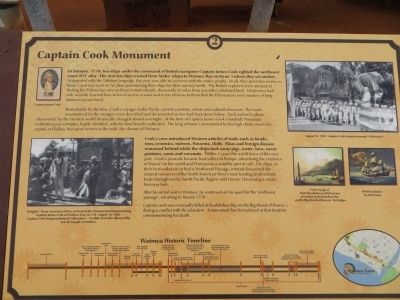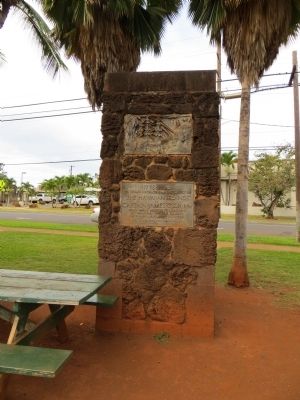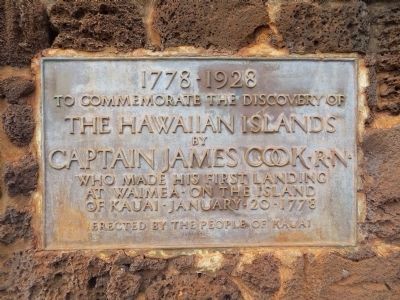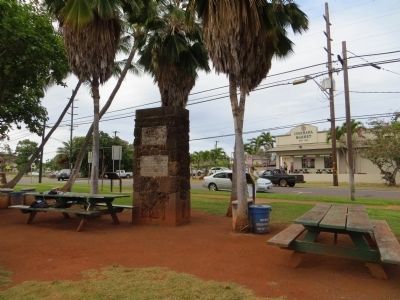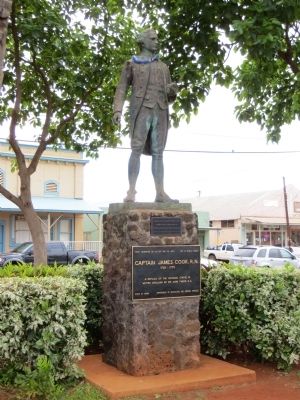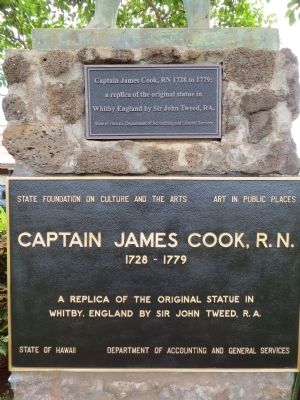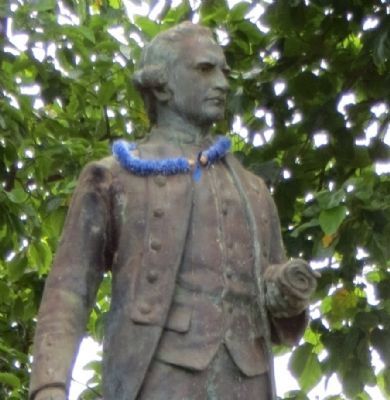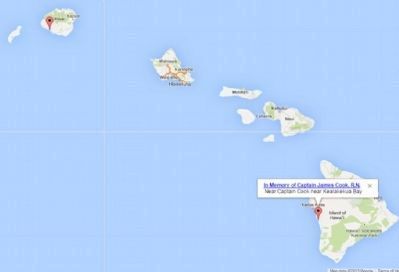Waimea in Kauai County, Hawaii — Hawaiian Island Archipelago (Pacific Ocean)
Captain Cook Monument
In January, 1778, two ships under the command of British navigator Captain James Cook sighted the northwest coast of O'ahu. The next day they cruised from Maha'ulepu to Waimea Bay on Kaua'i where they set anchor. Acquainted with the Tahitian language, the crew was able to converse with the native people. In all, they spent two weeks on Kaua'i and one week on Ni'ihau provisioning their ships for their journey north. The British explorers were amazed at finding the Polynesian race on these remote islands, thousands of miles from any other inhabited land. Westerners had only recently learned how to travel across oceans and it was obvious to them that the Polynesians were masters of long distance ocean travel.
Remarkable for the time, Cook's voyages in the Pacific carried scientists, artists and cultural observers. The lands encountered by the voyagers were described and documented as few had been done before. Each isolated culture "discovered" by the Western world drastically changed almost overnight. At the time of Captain James Cook's landfall, Hawaiian civilization was complex, highly stratified, with the land heavily cultivated. The king of Kaua'i surrounded by his high chiefs, made his capital at Wailua, but spent winters in the mild, dry climate of Waimea.
Cook's crew introduced Western articles of trade such as beads, iron, ceramics, mirrors, firearms, cloth. Fleas and foreign disease remained behind while the ships took away pigs, water, taro, sweet potatoes, yams and coconuts. Within 5 years the world knew of this new port. Cook's journals became best sellers in Europe, advertising the existence of Hawai'i to the world and Waimea as a suitable port of call. His ships, in their best endeavor to find a Northwest Passage, instead discovered the natural resources of the North American West Coast; leading to abundant trade throughout the North Pacific Region with Hawai'i becoming a major business hub.
After his initial visit to Waimea, he continued on his quest for the "northwest passage", returning to Hawaii 1779.
Captain Cook was eventually killed at Kealakekua Bay on the Big Island of Hawai'i during a conflict with the islanders. A monument has been placed at that location commemorating his death.
Topics. This historical marker and monument is listed in these topic lists: Arts, Letters, Music • Exploration • Science & Medicine • Settlements & Settlers • Waterways & Vessels. A significant historical month for this entry is January 1778.
Location. 21° 57.286′ N, 159° 40.026′ W. Marker is in Waimea, Hawaii, in Kauai County. Marker is at the intersection of Hawaii Route 50 and Panako Road, on the right when traveling west on State Route 50. Touch for map. Marker is in this post office area: Waimea HI 96796, United States of America. Touch for directions.
Other nearby markers. At least 8 other markers are within 14 miles of this marker, measured as the crow flies. Russian Fort Elizabeth (approx. ¼ mile away); Menehune Ditch (approx. 1.2 miles away); Spouting Horn Park (approx. 12.1 miles away); Prince Kūhiō Birthplace & Park (approx. 13.4 miles away); Yamamoto Store & Kōloa Hotel (approx. 13.4 miles away); Koloa, Birthplace of the Hawaiian Sugar Industry (approx. 13.4 miles away); Kōloa Missionary Church (approx. 13.4 miles away); Hanaka‘ape Bay & Kōloa Landing (approx. 13.8 miles away). Touch for a list and map of all markers in Waimea.
Related markers. Click here for a list of markers that are related to this marker.
Credits. This page was last revised on November 17, 2019. It was originally submitted on June 8, 2013, by Bill Kirchner of Tucson, Arizona. This page has been viewed 1,537 times since then and 59 times this year. It was the Marker of the Week January 18, 2015. Photos: 1, 2, 3, 4, 5, 6, 7. submitted on June 8, 2013, by Bill Kirchner of Tucson, Arizona. 8. submitted on January 17, 2015, by J. J. Prats of Powell, Ohio. • Syd Whittle was the editor who published this page.
